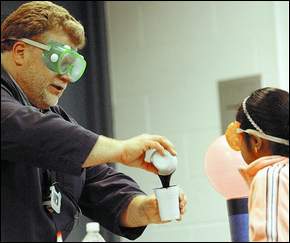 [By: Dr Dennis Regling] Getting students excited about science can be a challenge. If it is seen as memorization and bookwork many students will develop a fast aversion to it.
[By: Dr Dennis Regling] Getting students excited about science can be a challenge. If it is seen as memorization and bookwork many students will develop a fast aversion to it.
Our job as educators is to make science relevant to the young learner. One of the goals of STEM education is to integrate science, technology, engineering and math into all our lessons in natural and challenging ways.
Here is but a short list of ways we can create a positive attitude about science in our students:
1) Visual demonstrations. When I was in seventh grade, a local flour mill exploded. Our science teacher brought in a coffee can with a hose attached to demonstrate how flour (and dust) explodes. He explained how a powder explosion occurs, but then he demonstrated it to the class. He put loose flour under the can along with a lit candle. When a student blew into the hose, there was an explosion and the can flew into the air. I have never forgot that lesson. Our teacher incorporated science, current events and a visual captivating demonstration into a wonderful and exciting lesson.
2) Hands on experiments. This same teacher incubated chicken eggs in the classroom. Every few days, in small groups, we would break open eggs and draw the development of the embryo. Not just pictures in a book, but hands on learning again created interest and stimulated learning.
3) Teach children about the ways in which science and technology add value to the quality of human lives. If children understand all of the wonderful things technology has done and can do, (for example, the cell phone, the Internet, video games, cures for diseases, for example), then they are much more likely to get excited about what they can achieve by pursuing an education in science and technology.
Make sure children can relate to the examples you pick. Talk about curing illnesses rather than relating technological progress to something like cancer stem cell research. Young children will not understand highly technical language. If you can base your discussion of scientific progress in a story about someone or something a child is already familiar with (such as a family member or friend who has been ill), your message will be much more effective.
4) Bring science and technology closer to life by pointing out its daily applications. Help children understand how science and technology have led to such things as running water, electricity, and cars. Create a before-and-after scenario in order for your child to realize that people did not always have running water, electricity, or cars. By explaining the history of technology, your child will begin to comprehend that technology is related to progress and serves a very important purpose in day-to-day living.
5) Explain that science and technology can lead to fame and monetary gain. Appeal to students' fantasies and tempt them. Provide examples of great scientists and achievers. Consider assigning a home project out of researching the lives of famous scientists and innovators.
6) Encourage questions. Curiosity leading to inquiry provides the best foundation for perpetual self-improvement through study and experimentation. Encourage students to ask questions. Try not to brush aside their queries, even if they don't make sense or are not good questions. Turn the bad question into an interesting and relevant question and then engage in discussion. An important part of the process is helping your children learn how to find answers themselves through your guidance.
7) Schedule field trips to museums, farms, dairies and other businesses where students will be exposed to the use of technology and engineering to create the things we use everyday.
8) Host a school science fair. Encouraging students to personally explore the world around them can create a life long love for exploration. Rather than generic science fair topics that are prevalent in these events, have students pick a subject that interests them (sports, horses, fast food, etc.) and create an experiment or exploration into how science skills can be applied to that. By making the tasks personal students will have more interest and work harder.
9) Host a family science night. I have performed many a family science show at school science nights. Setting up many hands on displays in 1/2 the gym, teachers assist students in everything from blowing bubbles and making oobleck to playing with pulleys and levers. The evening is capped with a fun science show such as The Magic Of Science or Does Spaghetti Bounce.
10) Schedule a school show assembly. I perform hundreds of assembly shows every year. Exciting demonstrations, student volunteers and audience participation make science and math exciting and entertaining. Most of my shows include a few safe experiments students can replicate at home. The questions and interest the students show after the assemblies is amazing.
When you show science as an exciting, challenging pursuit rather than as "school work," you motivate a child's natural love of learning and create a love of exploration that just lectures and books cannot.
More Information:
Author and educator, Dennis Regling, presents educational school shows for grades K-8 throughout the east, midwest and south. For more details on bringing an educational and exciting school assembly show to your school, go to:http://www.greatassemblies.com
Published: May 30, 2014 ![]() Editors' Choice
Editors' Choice
Article Source: PopularArticles.comTM / Education / http://www.PopularArticles.com/article463035.html
Comments